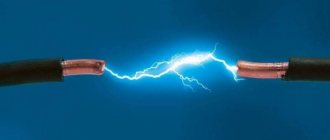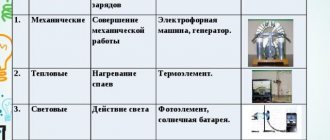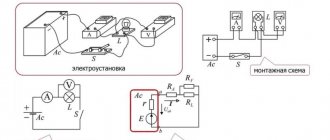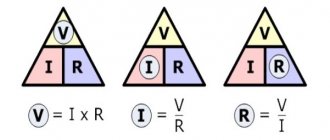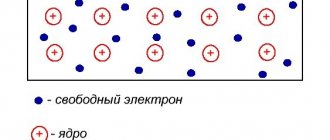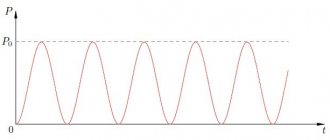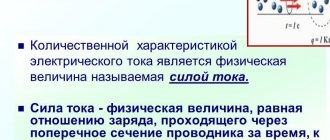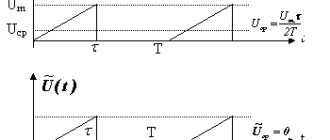We continue to publish materials in the new section “ Fundamentals of Electronics ,” and today’s article will talk about fundamental concepts, without which not a single electronic device or circuit can be discussed. As you may have guessed, I mean current, voltage and resistance . In addition, we will not ignore Ohm’s law (how could it be otherwise), which determines the relationship of these quantities, but I won’t get ahead of ourselves, let’s move gradually, and start with the concept of voltage.
What is voltage and current?
By the way, what exactly are electric current and voltage? I think that no one really knows, because to know it you have to at least see it. Who can see the current running through the wires?
Yes, no one, humanity has not yet achieved such technologies to personally observe the movements of electric charges. All that we see in textbooks and scientific works is some kind of abstraction created as a result of numerous observations.
Well, okay, we can talk a lot about this... So let's try to figure out what electric current and voltage are. I will not write definitions; definitions do not give the very understanding of the essence. If interested, take any physics textbook.
Since we do not see the electric current and all the processes occurring in the conductor, then we will try to create an analogy.
And traditionally, the electric current flowing in a conductor is compared to water running through pipes. In our analogy, water is an electric current. Water runs through the pipes at a certain speed, the speed is the current strength, measured in amperes. Well, pipes are a conductor in themselves.
Okay, we imagined electric current, but what is voltage? Let's help now.
The water in the pipe, in the absence of any forces (gravity, pressure), will not flow; it will rest like any other liquid poured onto the floor. So this force, or more precisely, energy in our plumbing analogy, will be the same tension.
But what happens to the water running from a reservoir located high above the ground? Water rushes in a stormy stream from the reservoir to the surface of the earth, driven by gravitational forces. And the higher the reservoir is located from the ground, the faster the water flows out of the hose. Do you understand what I'm talking about?
The higher the tank, the greater the force (read voltage) acting on the water. And the greater the speed of the water flow (read current strength). Now it becomes clear and a colorful picture begins to form in my head.
Let's sum it up:
What is electromotive force (EMF) - this is a physical quantity that characterizes the work of external forces in current sources (batteries, generators, etc.). EMF shows us the work of a current source in transferring charge through the entire circuit.
And voltage shows us the work of charge transfer in a section of the circuit.
What is tension in simple words? It is an external force that moves our ball in the example shown above.
And in electricity, it is the force that moves electrons from one atom to another.
Let me give you another example of what electrical voltage is:
Imagine that you can lift a stone weighing 50 kg, that is, your lifting force is 50 kg (in electricity, this is electromotive force). You are walking and on your way there is a stone weighing 20 kg, you take it and carry it 10 meters. You spent a certain amount of energy moving this stone (in electricity, this is voltage). The next stone already weighs 40 kg and to move it from one point to another you will spend more energy than you spent moving a stone weighing 20 kg. You always have the same lifting force (in electricity, this is EMF), but depending on the weight of the stone, you always spend a different amount of energy (in electricity, this is voltage). Those. On each leg of the journey you have different stress.
I hope you understand what electrical voltage is!
Concept of potential, potential difference
Closely related to the concept of electric current voltage is the concept of “potential”, or “potential difference”. Okay, let's go back to our plumbing analogy.
Our tank is located on a hill, which allows water to flow down the pipe freely. Since the water tank is at a height, the potential of this point will be higher or more positive than that at ground level. Do you see what happens?
We now have two points with different potentials, or rather different potential values.
It turns out that in order for electric current to flow through a wire, the potentials must not be equal. Current runs from a point with a higher potential to a point with a lower potential.
Remember this expression that current runs from plus to minus. So this is all the same. Plus is a more positive potential and minus is more negative.
By the way, do you want a question for backfilling? What will happen to the current if the potentials change places periodically?
Then we will observe how the electric current changes its direction to the opposite each time the potentials change. This will turn out to be alternating current. But we won’t consider it for now, so that a clear understanding of the processes can form in our heads.
Regulator characteristics
Self-made regulators can be manufactured and installed as a temporary or permanent device. The main characteristics that the regulator must have are:
- Possibility of gradual adjustment. It is best if the regulator has a special wheel with which you can smoothly adjust the difference between the reception and output of the signal.
- Power at which the regulator can operate stably. The higher the current strength at which it will operate without negative consequences for itself, the better for the device itself.
- An indicator of the maximum power that the regulator can withstand over a short period of time.
- Input voltage range.
- The type of signal that can be adjusted (direct or alternating current).
- Regulator control. It can be mechanical (using various mechanisms) or electronic (installed using remote controls or programming).
Voltage measurement
To measure voltage, a voltmeter is used, although multimeters are now the most popular. A multimeter is a combined device that contains a lot of things. I wrote about it in an article and told how to use it.
A voltmeter is just a device that measures the potential difference between two points. The voltage (potential difference) at any point in the circuit is usually measured relative to ZERO or GROUND or MASS or MINUS of the battery. It doesn’t matter, the main thing is that it should be the point with the lowest potential in the entire circuit.
So, to measure the DC voltage between two points, we do the following. The black (negative) probe of the voltmeter is stuck into the point where we can presumably observe a point with a lower potential (ZERO). We stick the red probe (positive) into the point whose potential is interesting to us.
And the result of the measurement will be the numerical value of the potential difference, or in other words, voltage.
Guess the riddle:
On one island there is an apple tree with a boy, and on the other there is a hospital with a grandmother. Bridge between the islands. The boy needs to bring 2 apples to his grandmother, but the bridge can only support one boy and one apple. After the boy passes, the bridge will collapse. And there are sharks in the water. How can he move the apples? Show answer>>
A cat is sitting on the window. The tail is like a cat, whiskers, paws, ears are like a cat, but she is not a cat herself. Who is this? Show answer>>
There is a pond on the window, and fish live in it. There are no fishermen on the glass shores. Show answer>>
Current measurement
Unlike voltage, which is measured at two points, current is measured at one point. Since the current strength (or they simply say current), according to our analogy, is the speed of water flow, this speed needs to be measured at only one point.
We need to cut the water pipe and insert a meter into the gap that will count liters and minutes. Something like this.
Similarly, if we return to the real world of our electrical model, we get the same thing. To measure the amount of electric current, we need to connect a simple device - an ammeter - to the open circuit of the electrical circuit. An ammeter is also included in the multimeter. You can also read my article.
The multimeter probes need to be switched to current measurement mode. Then we cut our conductor and connect the pieces of wire to the multimeter and voila - the current value will be shown on the multimeter screen.
Formula
The formula for electric voltage U, according to Ohm's law for a section of the circuit, has the form
U = R * I.
As can be seen from this formula, if the electrical voltage remains unchanged, then the greater the electrical resistance (R), the less the current (I).
Another formula for calculating electrical voltage is:
U = P/I.
That is, the electrical voltage U is equal to the power divided by the current I.
Ohm's law
Well, dear friends, I think we didn’t waste our time. Having become familiar with our plumbing models, a puzzle began to take shape in my head and an understanding began to form.
Well, let's try to check it using Ohm's law.
Where:
- I - current measured in Amperes (A);
- U-voltage measured in Volts (V);
- R-resistance measured in Ohms (Ohm)
Ohm told us that electric current is directly proportional to voltage and inversely proportional to resistance.
I didn’t talk about resistance today, but I think you understand. The resistance to electric current is the material of the conductor. In our plumbing system, resistance to the flow of water is provided by rusty pipes clogged with rust and other things.


